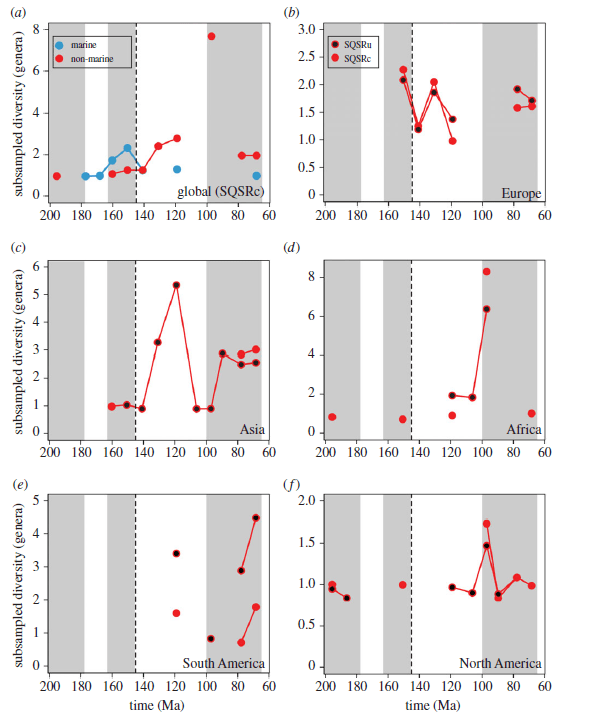Ecological reshuffle following a crocodyliform extinction
Chaaaaange places! Sometimes, when extinction hits it’s not quite the dramatic ‘great dying’ we might think of where animals choke their final breaths out in the desolate, lifeless wastelands. Sometimes, it’s more like the Mad Hatter’s tea party from Alice in Wonderland: chaotic, messy, no major character dies, but you can be sure that something pretty weird and dramatic has just happened.
Well, I think this is what happened around 145 million years ago at the Jurassic/Cretaceous boundary. In a recent paper, we analysed the diversity and extinction patterns of crocodyliforms – the group that includes modern crocodiles and their super cool ancestors – and found that they got hit pretty hard by an extinction event around this time.
I’ve written before elsewhere at problem in looking at diversity in the fossil record, it’s not a simple case of what you see is what you get. In fact, it couldn’t be further from the truth a lot of the time. The fossil record sucks. We just have to find out in what ways it sucks, and learn how to deal with that (aka science). That’s what we did in our study, which is essentially a chapter of my thesis. We explored different ways of measuring crocodyliform diversity and extinction through time, and found that they got hit pretty hard around the Jurassic/Cretaceous boundary.

This probably wasn’t a singular catastrophic event like the end-Cretaceous mass extinction though. While there is evidence for massive volcanism and several meteor impacts around this time, it’s actually very difficult to tie these to changes in long term patterns as you can’t assess single events statistically. Instead, the causes of this extinction were probably more tied to changes in sea level. Sexy eh.
Over 10s of millions of years, crocodyliform diversity seems to be strongly tied with changes in sea level: it goes up, diversity goes up; it goes down, you lose habitable areas, and extinction happens. Common sense perhaps, but now backed up by science!

Now crocs at this time were nothing like today. In the seas, we had sleek, shark-like and flippered forms called thalattosuchians, that even had salt glands so we know were capable of swimming out to sea. On land, croc faunas were more composed of small-bodied, lagoonal or swamp dwelling beasties. When sea level changes, you can envisage how this wouldn’t be too great for either of these groups.
What we think happened is that a major sea level fall, or regression, throughout the Jurassic/Cretaceous boundary was responsible for a pretty hefty extinction in crocs, with up to 80% of known species going kaput at this time! Now I’m pretty sure this is where the well-known saying ‘One crocodiles trash is another crocodile’s treasure’, as while these crocodiles got trashed, it seemed to be brilliant for others!

A phenomenon known as ecological replacement is where one group that was previously dominant gets replaced by groups more capable to adapting to new and changing environments. We think this is what happened on land: the smaller crocs went extinct, paving the way for new groups. This included the armoured, vegetarian notosuchians, as well as eusuchians, which led the way to modern crocodiles!
In the seas, it was a bit different. When marine crocs, the thalattosuchians, they didn’t recover, sadly. Some marine crocs still existed in the Cretaceous afterwards, like dyrosaurids and pholidosaurids, but they never reached the Jurassic dominance that thalattosuchians had. They didn’t leave easily either – while they might have taken a battering at the Jurassic/Cretaceous boundary, their numbers dwindled for around another 10 million years, before changing sea levels led to episodes of oceanic stagnation and anoxia, proving to be the finishing touch on their terminal decline.

In their wake though, we see something pretty neat. As apex predators, the loss of thalattosuchians meant that there was now space in ecosystems for new predators to rise. That’s actually what we see in the fossil record too! New groups of plesiosaur appear to radiate, and genomic evidence puts the origins of almost all major shark lineages around this time. In addition, the easing of predatory pressure might have been the cause of the radiation of marine turtles, with the origins coinciding (on a geological time scale), with the extinction of Thalattosuchia.
So what we see overall is a reshuffling of marine predatory groups, and a case of out with the old and in with the new in crocs that lived closer to land.
Discovering this was only thanks to the huge efforts that went into data collection for the Paleobiology Database, and some intensive smashing of the keyboard trying to get R and Perl to do science for me. All of the detailed methods (boooriiiiiing) are in the paper, and all the data is available for the study here thanks to the awesome partnership between the Royal Society and Dryad, and do you even need to ask if the paper is open access at this point?*
Thanks to Colin Smith for working on this at the Press Office at Imperial College! Here’s the original press release, and it was picked up by numerous sites including RD Mag, HNGN, Gazeta, SciLogs (ta Travis!), EurekaAlert, PhysOrg and Cosmos Magazine.
*I should note that this is because I have the privilege of being a government-funded researcher which has dedicated considerable amounts of money towards paying for this on researchers behalves.